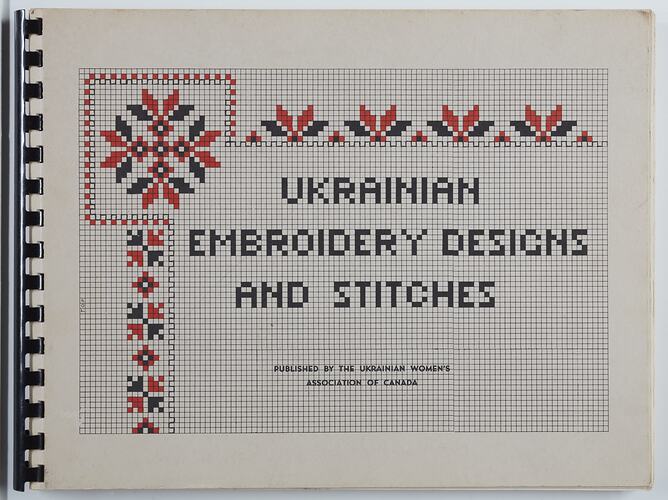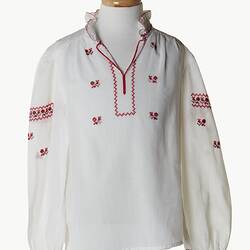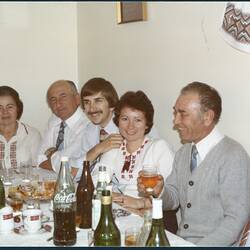Summary
Spiral bound book entitled 'Ukrainian Embroidery Design and Stitches' published by the Ukrainian Women's Association of Canada, 4th edition, Manitoba, 1978 (first published in 1958). Compilied and edited by Nancy R. Ruryk. Cover design by Rose Dragan.
The book contains a foreword giving a history of the Ukraine Women's Assocation of Canada and two historical photos, and a map of Ukraine in 1951. It has a section with photographs of women and children attired in clothes featuring various embroidery patterns.
It was purchased by Natalie Senjov-Makohon from Mr Foksham's shop, a post World War II Ukrainian migrant who owned a bookstore in Glenroy specialising in Ukrainian publications from Canada.
This item is part of a collection of textiles, cultural objects and photographs relating to the migration and settlement experiences of Katerina Senjov, and her daughter Natalie Senjov-Makohon who inherited her mother's passion for maintaining her Ukrainian cultural heritage.
Katerina Senjov (nee Burlak) and her husband Peter migrated to Melbourne from what is now Bosnia-Herzegovina in 1954. Despite growing up in Bosnia, the Senjov and Burlak families always culturally identified as Ukrainians and spoke Ukrainian.
They settled first in Geelong and then in Ascot Vale, had two children Natalie and Steven, whom they encouraged to learn traditional Ukrainian culture and traditions. The Senjovs actively participated in the Ukrainian community (including choirs, dance groups and gatherings wearing traditional regional clothing usually made by Katerina or her daughter Natalie).
The mother and daughter produced, wore, used, purchased and received, a range of Ukrainian cultural items including embroidered domestic and religious textiles, Ukrainian textile design publications, Pysanky (hand-painted eggs), a Bandura (stringed musical instrument) and timber inlay artworks.
Physical Description
Black spiral bound pale brown book; 130 pages of black printed text on white sheets; colour and black and white patterns.
Significance
This collection provides a significant representation of traditional Ukrainian life and cultural practices subsequently transported to Australia through migration, and retained as part of the preservation, maintenance and adaptation of cultural life. In this family there was a strong and active passing down of cultural traditions, particularly down the female line.
The Museum holds a range of regional costumes, or costume components, from Sardinia, Latvia, Estonia, Poland, South Africa, Albania, Scotland, Greece, Hungary, Slovenia and Argentina; this collection relating to Ukraine further strengthens and expands the cultural representation of the collection. This material has been worn and used, is well provenanced, and has accompanying photographic documentation. This collection is also an important addition to the currently small collection relating to Ukrainian migration and settlement experiences.
The collection also includes domestic and religious Ukrainian embroidery and weaving, books documenting traditional Ukrainian designs used as references by the makers in Australia, Pysanky (painted eggs) in the tradition of many eastern European countries including Ukraine, and a Bandura (Ukrainian traditional musical instrument).
These items were all of importance in the expression of identity and place, some in the country of origin, and all in the place of re-settlement. Some of the costume pieces have played a role in the activities of community organisations in Australia; like similar associations, maintaining cultural practices and customs is increasingly challenging as subsequent generations become further distanced from the original migrant generation and through the natural process of community settlement, integration and assimilation within the context of a multiculturally diverse society.
More Information
-
Collection Names
-
Collecting Areas
Migration & Cultural Diversity, Clothing & Textiles, Home & Community, Leisure
-
Previous Owner
Natalie Senjov-Makohon, Melbourne, Victoria, Australia, 2024
-
Date Published
-
Inscriptions
Cover: 'UKRANIAN EMBROIDERY DESIGNS AND STITCHES / PUBLISHED BY THE UKRAINAIN WOMEN'S ASSOCATIAN OF CANADA'
-
Classification
Cultural identity, Ethnicity - creative practice, Needlework
-
Category
-
Discipline
-
Type of item
-
Overall Dimensions - Closed
290 mm (Width), 220 mm (Height)
-
Keywords
Ukrainian Immigration, Folk Festivals, Needlework, Handcrafts, Cultural Traditions, Embroidery, Weaving, Sewing, Cultural Identity, Artworks, Crafts


